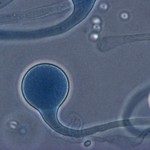Link to Pubmed [PMID] – 34022772
Link to DOI – myab02710.1093/mmy/myab027
Med Mycol 2021 May; ():
Black aspergilli of the section Nigri are rarely differentiated at the species level when originating from human specimens. We wondered whether some cryptic species could be more frequently observed in some clinical entities. We analyzed the 198 black isolates consecutively collected from the external ear canal (EEC; n = 66), respiratory specimens (n = 99), and environment (n = 33). DNA was extracted and species identification was performed upon the partial calmodulin gene. We identified by decreasing frequency: Aspergillus welwitschiae (35.3%), Aspergillus tubingensis (34.3%), Aspergillus niger (17.2%), Aspergillus luchuensis (4%), Aspergillus aff. welwitschiae (3%), Aspergillus neoniger (2%), Aspergillus piperis (1.5%), Aspergillus japonicus (1.0%), Aspergillus vadensis (0.5%), and two Aspergillus tubingensis clade (1%). The distribution of the three main cryptic species was different between EEC and respiratory samples (P < 0.001) but not different between respiratory and environment samples (P = 0.264). Aspergillus welwitschiae was more often associated with EEC (54.5%), whereas A. tubingensis and A. niger were predominant in respiratory samples (39.4 and 26.3%, respectively). Among the 99 respiratory isolates, only 10 were deemed responsible for probable invasive aspergillosis, of which six were mixed with other pathogenic moulds. This study shows the interest to pursue the identification of clinical isolates in the Aspergillus section Nigri to unravel some specific associations with clinical entities. The association of A. welwitschiae with otomycosis suggests a better fitness to infect/colonize the ear canal. Also, members of the Aspergillus section Nigri alone are rarely responsible for invasive aspergillosis.We analyzed 198 black aspergilli isolates collected from different samples type to determine their species identification. We observe a different distribution of species between ear canal and respiratory samples (P < 0.001), suggesting a better fitness of A. welwitschiae to infect the ear canal.





